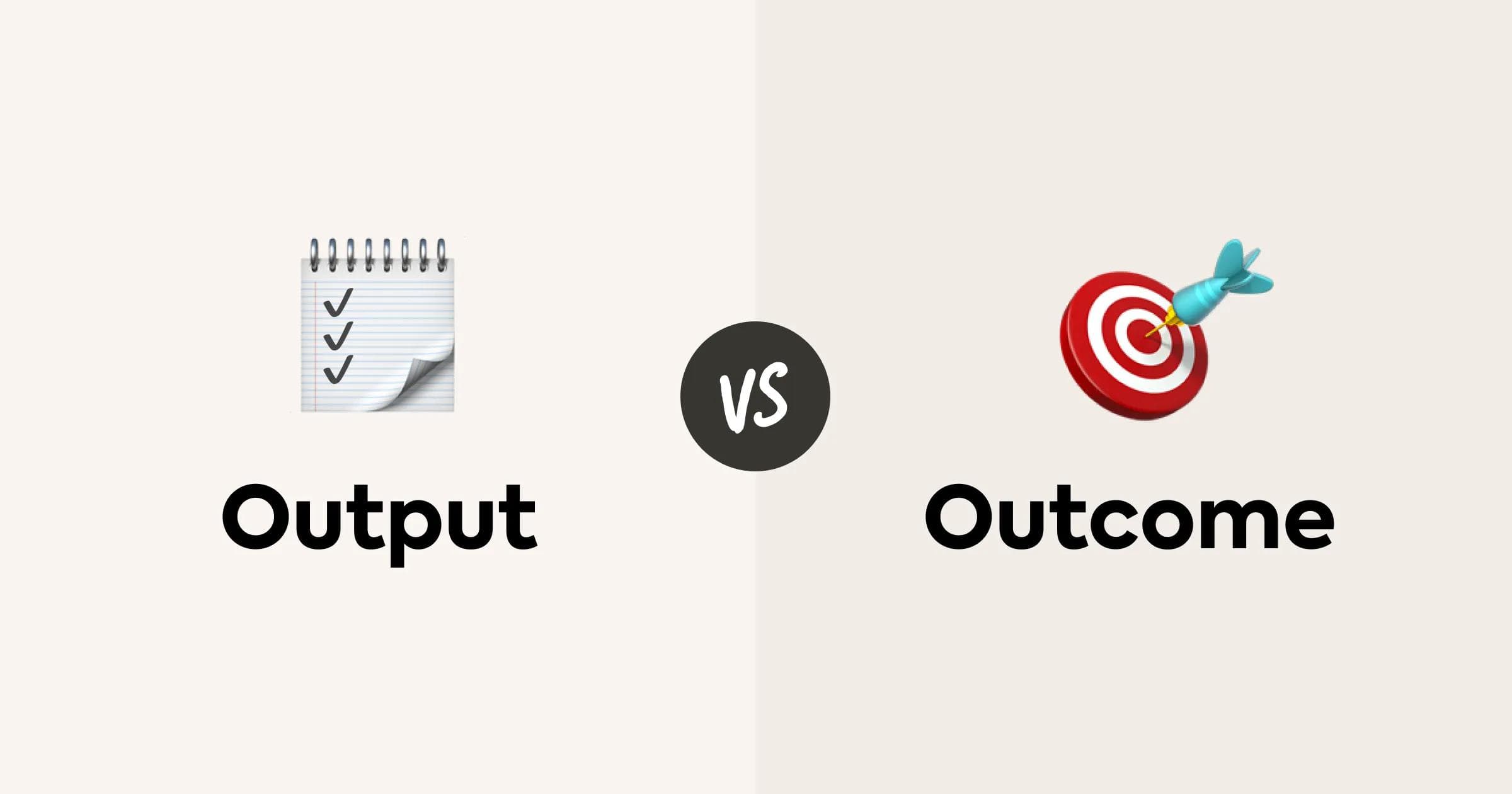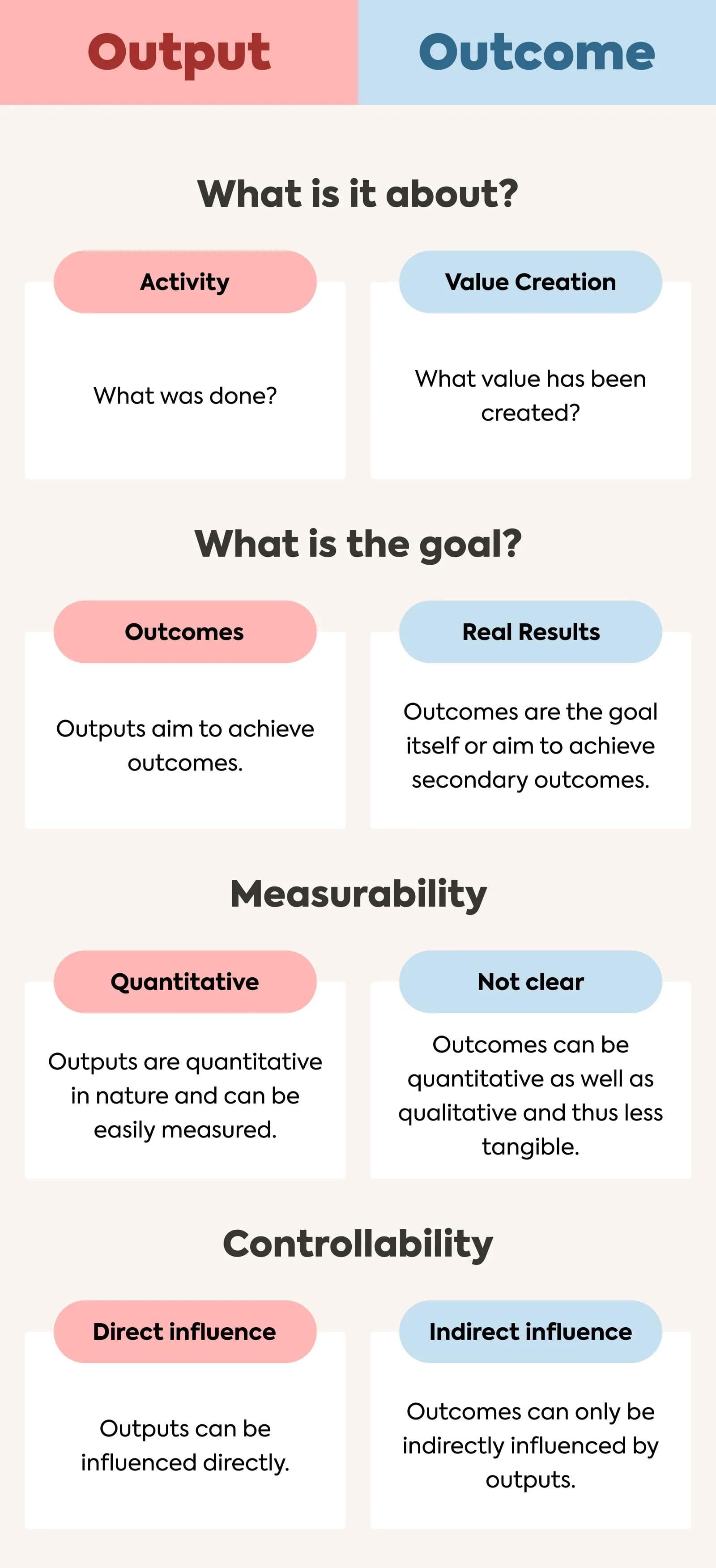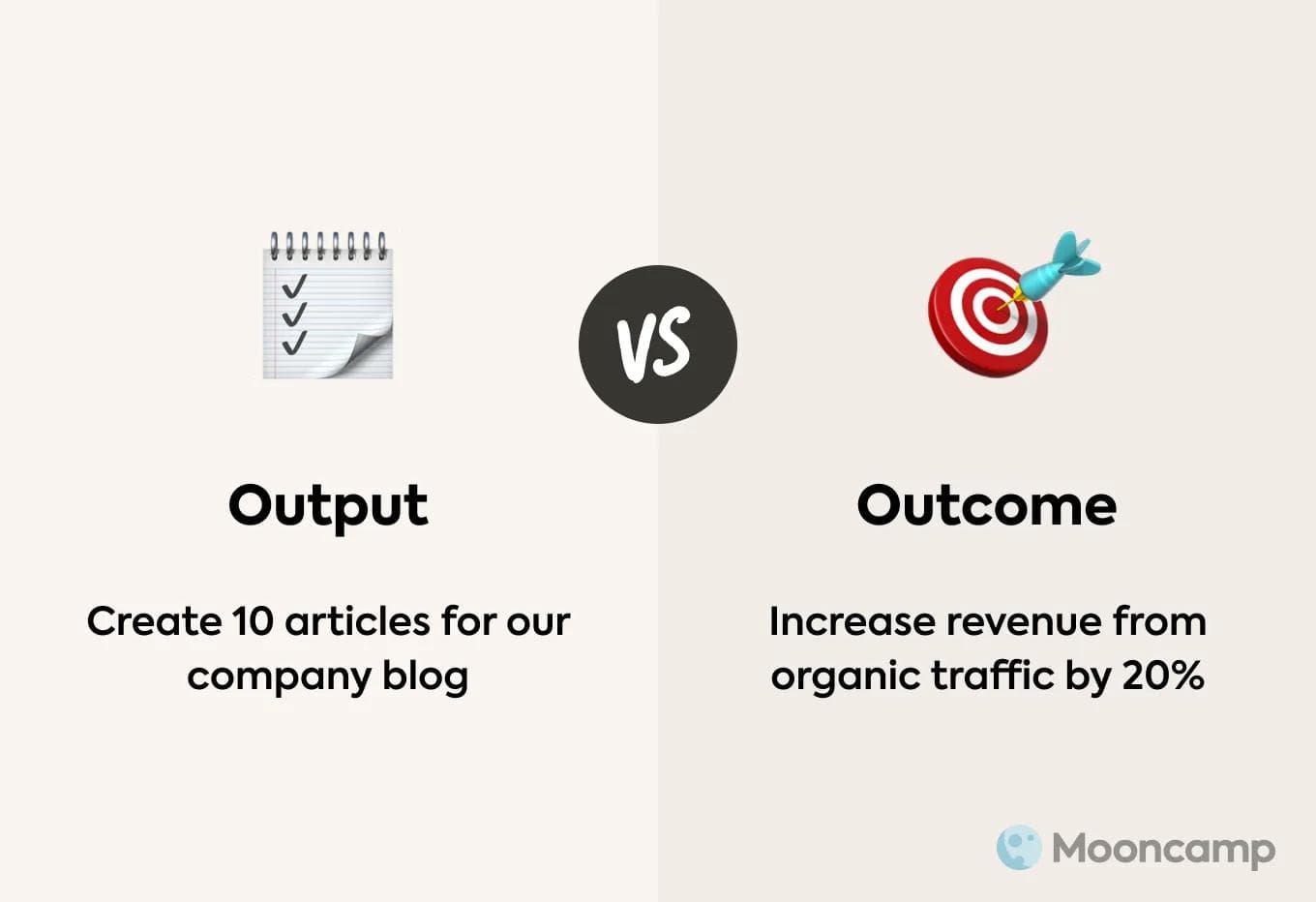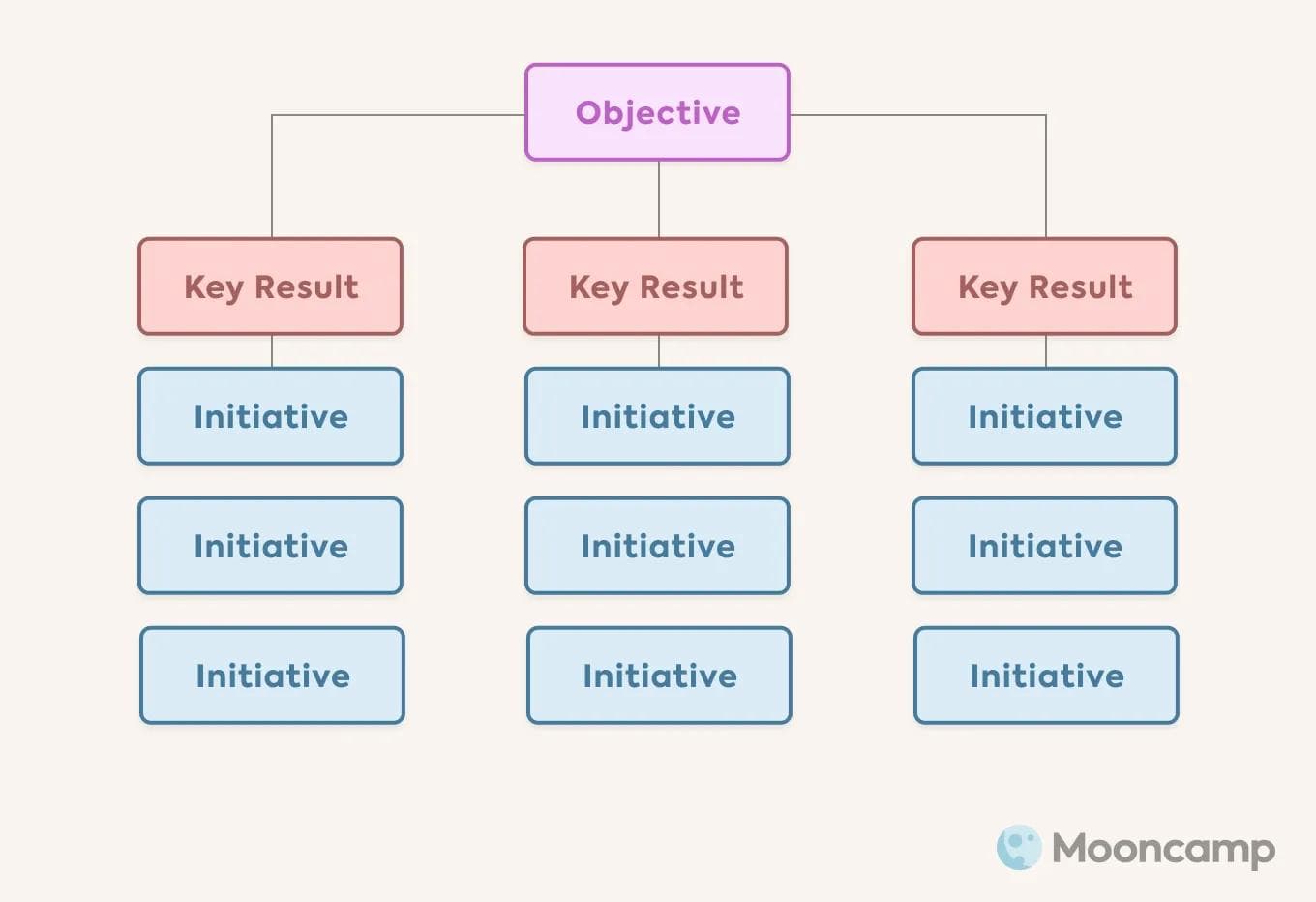Output vs. Outcome: Understanding the difference for successful OKRs

Two terms lead the ranking of misunderstandings in the world of agile management: "output" and "outcome". Far too often they are used as synonyms – although they are actually two entirely different things…
This becomes clear when you take a closer look at OKRs. Nevertheless, many companies make the same mistakes again and again when they introduce OKRs.
To ensure this doesn't happen to you, we'll explain the differences between outcome and output in this article. We will also cover the role of the two concepts in the OKR framework and you will see why it pays off for you and your company to truly focus on outcomes.
What to expect:
- Output vs. Outcome – Definition
- Output vs. Outcome – What are the differences?
- Why does the distinction matter?
- What role do output and outcome play in OKRs?
- OKR Output vs. Outcome – an example
- Conclusion: outcomes are the only way to push your company forward
- Outcome vs. Output – FAQ
Outputs vs. Outcomes – Definition
The word output describes the result achieved by a specific activity. It refers to a product, service, or other tangible result of working on a project.
Outcome takes this one step further: the term refers to the effect achieved with the output. In other words, outcome describes the actual added value that a product or service creates for the target group.
In summary, outcomes are the goals you want to achieve with your business, and output is the result of concrete activities or initiatives you undertake to make progress towards achieving those goals.
Inputs vs. Outputs vs. Outcomes – and don’t forget the Impact
The terms input and impact are also commonly used in everyday business life. They are closely related to outputs and outcomes. Therefore, they will also be defined here.
Input is what is needed to achieve a certain result – for example, financial, personnel-related, or time resources. All these "ingredients" are then transformed into output through activities.
The impact, on the other hand, is defined as the long-term and sustainable benefit that the achieved outcomes have for a company. The boundaries between outcomes and impact are fluid.
Output vs. Outcome – What are the differences?
With the clarification of the terms, the difference between output and outcome already begins to emerge. However, we will first take a detailed look at the two and compare outputs vs. outcomes with one another:
Outputs describe what exactly has been completed, for example, in different projects or during working hours.
Outcomes, on the other hand, are what you have worked towards. They express what value you have created with your work.
Thus, the goal of outcomes is to produce real, valuable, tangible results, while outputs are aimed at achieving higher-level goals. Setting up a new marketing plan (output) doesn't automatically mean it will be good and bring in a lot of new customers (outcome).
Put simply, it is much easier to measure outputs than outcomes.
Outputs are almost always quantitative and it is easy to see whether they have been achieved or not. When it comes to outcomes, things look a bit different.
Outcomes can be both qualitative and quantitative, it is harder to clearly define whether they have been achieved or not. Success or failure depends largely on the perception of the target group. That makes it much more complicated to measure outcomes.
Whether you have achieved the desired output, on the other hand, is easy to determine when, for example, a recently completed new product design stands tangible and physical in front of you on your desk as a prototype.
Output and outcome also differ in terms of flexibility: The desired outcome is defined once and then remains the same until it is accomplished. Outputs are more short-term and can change if you don't achieve the intended outcomes.

Output, Outcome, Impact – Why does the distinction matter?
Outputs basically only show that something has been done – but by no means show whether this has also brought a real benefit. Ultimately, it is precisely this impact that boosts a company's performance.
Without understanding the difference between outputs and outcomes, most people unconsciously work with output measures. This usually leads to two central problems: low business value and unmotivated employees.
Success is measured incorrectly
Most companies have not yet learned to think in outcomes. It requires time, patience, and practice.
Instead, most corporate cultures are still characterized by an outdated way of thinking that dates back to the industrialization era: a lot of input leads to a lot of output, which in turn means success.
Lots of activity and input are rewarded—full schedules, important meetings, and 60-hour weeks earn appreciative nodding from the manager. The fact that the co-worker who is clocking out at 4 p.m. every day achieves twice as many outcomes in half the time is not or only rarely acknowledged in output-oriented companies.
Those who produce a lot appear successful. Whether the products actually create added value or the twentieth Excel sheet really improves the effectiveness of a process is often irrelevant.
Thus, an organization may appear successful at first glance, but in the end it is not working effectively and/or focusing on the wrong things.

The "big picture" perspective is missing
From the employee perspective, a focus on outputs also leads to a motivation problem: if everything in the daily work routine revolves around outputs, the employees mostly just work off tasks without really knowing what impact their work has on the company.
This way of working is now anything but contemporary: young talents are no longer looking for employers where they do "duty by the book". They want their work to be self-fulfilling, meaningful, and of real benefit.
Inevitably, if a lot of hard work is done without a clear, meaningful goal, sooner or later employee motivation will drop. Valuable potential remains unused.
What role do output and outcome play in OKRs?
OKRs (Objectives and Key Results) are popular with companies that want to become more agile. The acronym stands for a management method for goal-oriented, modern and flexible employee management, which is based on a few simple principles and if applied correctly allows companies to move towards greater transparency, alignment, focus and agility.
Every quarter (or more frequently, depending on what suits the team best), a number of qualitative, inspirational goals (Objectives) are set, each of which is linked to two to four measurable metrics (Key Results) that can be used to monitor whether the objectives have been achieved. That sounds quite simple, doesn't it?
Real results instead of to-do lists
When it comes to proper application, many OKR newbies fail to distinguish between output vs. outcome.
If you stick to old thinking patterns and fail to formulate Key Results in an outcome-driven manner, but instead create a list of check-off activities and to-dos i.e. work in an output-driven manner, you will not actually introduce any real OKRs.
OKRs are about achieving results that bring real (business) benefits. If you are not prepared to explore new ways and to say goodbye to action-based thinking, you will not achieve the hoped-for effect with OKRs.
Only when each Key Result is framed in a way that actually represents relevant outcomes can you truly measure whether you are successful on the way to achieving your Objective.
Initiatives are for output
The output is only in focus when so-called initiatives or activities are being formulated. These generate the output and can, for example, be larger projects, measures or even individual tasks. Initiatives and activities should be designed in such a way that they generate work products that have a positive impact on the Key Results.
This means that output also has its place in the OKR framework, though not, as is often wrongly assumed, in the Key Results, but rather one level deeper in the initiatives and activities that are necessary to achieve the Key Results and Objective.

OKR Output vs. Outcome – an example
Using the following example from social media marketing, where the focus is on the outcome, the difference becomes even clearer:
🚀 Objective
Make our social media channels a hub for our community and prove its strategic value
Key Results
- Increase share of social referral leads to 15%
- Increase social referral traffic by 40%
- Grow Facebook followers to 100,000
- Grow Twitter followers to 30,000
Initiatives
- Run 5 social ad campaigns on Facebook
- Run 3 sweepstakes with giveaways on Facebook
- Integrate CTAs into all social media posts
- Publish 3-5 posts per week on Facebook and 1-2 per day on Twitter
- Establish contact with at least 3 influencers and complete at least one collaboration
For more examples that can help you formulate your own outcome-based OKRs, check out our collection of OKR examples.
Conclusion: why focusing on outcomes drives business growth
All in all, we can conclude that output shows that something has been done – and the outcome, whether the work has also brought real value. This value is what drives a company forward.
However, many companies focus only on outputs instead of real, impactful, and measurable outcomes. That's why they don't succeed with OKRs.
Objectives and Key Results should therefore always be formulated in an outcome-oriented way. With outcome-based OKRs, teams have a clear goal in mind and can work together towards this goal within a fixed time frame—independently using methods and tools of their own choice.
In this way, each employee can develop their full potential and contribute to the overall success of the company. Consequently, employees are significantly more motivated compared to working exclusively through tasks.
Outcome vs. Output – FAQ
What is output and outcome?
Outcome is defined as a result or goal that you want to achieve and that has an overriding business value. Output is defined as concrete work products (e.g. products or services) that result from an activity.
How do output and outcome differ?
Outputs are the direct products of what one has done during working hours. They show "how much" a person has accomplished. Outcomes, on the other hand, express what value or benefit one has created with their work. They show "why" someone did "what."
What do OKRs have to do with output and outcome?
OKRs help organizations operationalize outcomes and become more results-oriented. Outcomes are defined measurably within the framework (in the form of an Objective and several Key Results) and achieved through the direct results of activities or initiatives (output) that are also defined in advance.
How to find good key results?
Key Results should always be outcome-driven and not just a list of activities and to-dos to be checked off. When defining Key Results, you should always be like a curious child who keeps asking, "But why?". The why question helps you to move from initial ideas (which are mostly outputs) to truly outcome-based Key Results.

